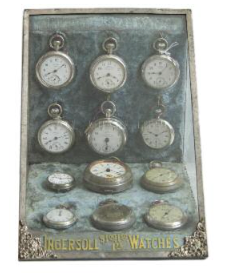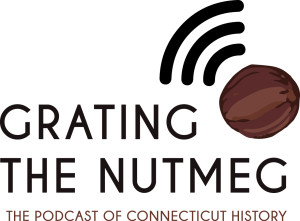By Emily Gifford
(c) Connecticut Explored. Winter 2015-2016
Subscribe/Buy the Issue!
Timex Group is one of the largest watchmakers in the world. Founded in 1854 as Waterbury Clock Company, Timex Group is a privately held company with its U.S. headquarters in Middlebury, Connecticut.
The modern history of Timex begins with a partnership between the Waterbury Clock Company and Robert and Charles Ingersoll of Robt. W. Ingersoll Bros. in New York. Starting in the 1880s, Robert was particularly invested in products that sold for a dollar (the equivalent of about $23 to $25 in 2015). Ingersoll Bros. produced a wide range of such products, from toys to typewriters.
Robert considered the possibility of a $1 pocket watch. At the time, the least expensive pocket watches sold for over $2 and could run into the $40 range. He found that Waterbury Clock Company and New Haven Clock Company were making pocket watches that were surprisingly inexpensive, although still above Ingersoll’s preferred price point. In 1892, he contracted Waterbury Clock Company to make watches.
 By 1894 Waterbury Clock was turning out half a million Ingersoll watches a year. By 1896 the company had developed the Ingersoll “Yankee” pocket watch, which sold for a dollar. Within five years, Ingersoll had sold six million Yankees, which were seen as good value.
By 1894 Waterbury Clock was turning out half a million Ingersoll watches a year. By 1896 the company had developed the Ingersoll “Yankee” pocket watch, which sold for a dollar. Within five years, Ingersoll had sold six million Yankees, which were seen as good value.
Wristwatches were introduced in World War I, and after the war, the demand for them soared. Ingersoll and Waterbury Clock responded handily, but a series of unfortunate business and personal events bankrupted Ingersoll. In 1922 Waterbury Clock bought Ingersoll’s U.S. operations and began directly marketing the Ingersoll brand, which they used through the late 1940s.
One particular technological innovation came at a steep price. In the early 1920s, several clock manufacturers, including Waterbury Clock, used a newly discovered element, radium, to illuminate the numbers on clock and watch faces. The women employed to hand-paint them frequently licked their brushes’ bristles to form a fine point. Within a year, the first of the workers began to suffer ailments related to the practice, particularly oral and facial cancers, as Claudia Clark chronicles in Radium Girls: Women and Industrial Health Reform (The University of North Carolina Press, 1997). Waterbury Clock Company and its successor companies US Time Corporation and Timex have all been reticent about, even mute on, the subject. The Waterbury Observer ran a story about the tragedy and the environmental cleanup required of the factory sites in 2002, claiming that it was the first about the subject in the history of Waterbury newspapers.
Kathleen McDermott, in the company-commissioned Timex: A Company and Its Community, 1854-1998, notes that by 1928 the Waterbury Clock Company was itself on the verge of bankruptcy. The company acquired timepiece-licensing rights that have been credited with saving the company: a one-year-old cartoon character named Mickey Mouse. The resulting Mickey Mouse watches debuted at the 1933 Chicago World’s Fair, and they became so popular that in the depths of the Great Depression, Waterbury Clock rehired workers and expanded its plant. World War II brought additional prosperity to Waterbury Clock in the form of military contracts for timepieces, bomb fuses, and gyroscopes. It was a new era in ownership, too. Thomas Olsen and Joakim Lehmkuhl escaped their home country of Norway in April 1940, just as Germany invaded. Less than a year later, in February 1941, Olsen bought a majority stake in Waterbury Clock, bringing Lehmkuhl with him to serve on the board. In 1942, they built a 120,000-square-foot manufacturing plant in Middlebury to serve the company’s ever-increasing number of contracts with the militaries of the United States and the United Kingdom. They changed the company’s name to United States Time Corporation in 1944.
World War II brought additional prosperity to Waterbury Clock in the form of military contracts for timepieces, bomb fuses, and gyroscopes. It was a new era in ownership, too. Thomas Olsen and Joakim Lehmkuhl escaped their home country of Norway in April 1940, just as Germany invaded. Less than a year later, in February 1941, Olsen bought a majority stake in Waterbury Clock, bringing Lehmkuhl with him to serve on the board. In 1942, they built a 120,000-square-foot manufacturing plant in Middlebury to serve the company’s ever-increasing number of contracts with the militaries of the United States and the United Kingdom. They changed the company’s name to United States Time Corporation in 1944.
When the war ended, U.S. Time found itself in financial straits once again, and returned to marketing inexpensive timepieces for civilian use. In 1944 U.S. Time had introduced a limited-edition watch, the Timex, which it developed for nurses. This first Timex was a pendant on a 10-inch chain that nurses affixed to their uniforms. U.S. Time trademarked the Timex name in 1946 but didn’t begin marketing Timex wristwatches commercially until 1950. Sales increased steadily, and by 1954 Timex was a widely known and popular brand.
U.S. Time found the perfect pitchman in John Cameron Swayze, a former NBC news anchor who, when hired by U.S. Time in 1956, had just lost his anchoring job to the team of Huntley and Brinkley. In his live television commercials, Swayze oversaw “torture tests” of Timex watches. In each demonstration, a Timex endured the latest attempt to destroy it, ranging from being put through dishwashers to being jackhammered. As watches passed their various tests, Swayze would deliver the iconic slogan: “It takes a licking and keeps on ticking.”
Timex moved its headquarters and research and development facilities to Middlebury by the early 1960s. To the public, the U.S. Time Corporation was Timex, so the company changed its name to Timex in 1969, at the same time it was moving its manufacturing facilities out of Connecticut. The Waterbury building that had originally housed corporate headquarters became the home of the Timexpo Museum in 2001.
In the 21st century, Timex, now owned by Dutch holding company Timex B.V., went into the luxury market, producing watches for Versace and other high-fashion labels; today, the Timex-driven Versace models can cost as much as $1,750.
 Unfortunately, the Timexpo Museum did not find a broad enough audience to sustain itself and closed on September 30, 2015. The Mattatuck Museum in Waterbury has an agreement with Timex to host a small permanent exhibition of objects on long-term loan from the company. Waterbury Clock, U.S. Time, and Timex watches may also be viewed at the American Clock and Watch Museum in Bristol.
Unfortunately, the Timexpo Museum did not find a broad enough audience to sustain itself and closed on September 30, 2015. The Mattatuck Museum in Waterbury has an agreement with Timex to host a small permanent exhibition of objects on long-term loan from the company. Waterbury Clock, U.S. Time, and Timex watches may also be viewed at the American Clock and Watch Museum in Bristol.
Emily E. Gifford is an independent scholar and a member of the Connecticut Explored editorial team.
Explore!
 LISTEN to our podcast, Grating the Nutmeg, episode 4
LISTEN to our podcast, Grating the Nutmeg, episode 4
READ Everyman’s Time: The Rise and Fall of Connecticut Clockmaking, Fall 2007
READ more stories about iconic products Made in Connecticut on our TOPICS page.
VISIT
American Clock & Watch Museum, 100 Maple Street, Bristol. 860-583-6070, clockandwatchmuseum.org
Mattatuck Museum, 144 West Main Street, Waterbury. 203-753-0381, mattatuckmuseum.org

